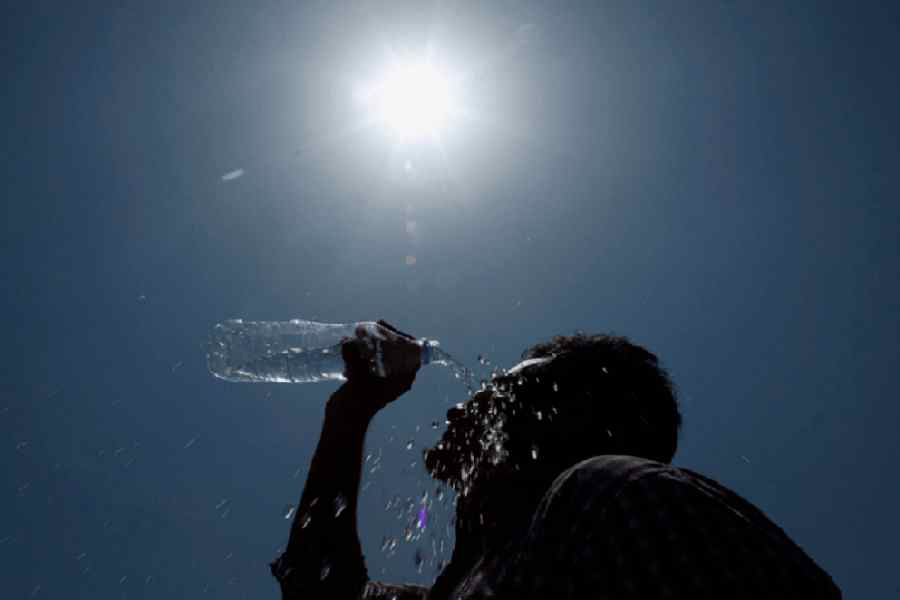A study of south Bengal’s rainfall figures over 60 years from 1961 shows a clear decline in the amount of rain in early monsoon and an increase in rain in the latter part of the season, often stretching into October.
The change in pattern, which emerged in the study conducted by the state environment department, could have serious implications in agriculture. It also increases risks of flooding and waterlogging in cities.
The shift has not been noticed in north Bengal, said those associated with the study.
The data was procured from the India Meteorological Department. The Indian Statistical Institute sorted the data and did a preliminary analysis for the state. The analysis was done as part of the efforts to prepare a climate action plan for the state.
Rainfall data from 1901 was collected and the period was divided into four blocks of 30 years each. The study pinned down on 60 years, a period imprinted in living memory.
“We compared the period 1961 to 1990 with the period 1991 to 2020. We found a clear shift in the rainfall pattern in south Bengal — especially the Gangetic alluvial plain and the coastal zone. There has been a decline in early monsoon rain or rainfall in June and a simultaneous increase in late monsoon rain, starting September and stretching till October,” said Kalyan Rudra, a member of the committee formed to prepare the State Action Plan on Climate Change and the chairperson of the state pollution control board.
The rainfall data, along with temperature data, was procured as part of preparation of the action plan.
The decline in the volume of rain in June and an increase in September and October can have serious impact on agriculture, hitting both kharif (monsoon) and rabi (winter) crops, said scientists.
Jute and paddy cultivation can suffer because of a change in the rainfall pattern, said Gautam Saha, the vice-chancellor of Bidhan Chandra Krishi Viswavidyalaya and a professor of agricultural meteorology.
“Jute is sown during the pre-monsoon period, when the state receives kalbaisakhi (Nor’wester) rain, with the aim that it will grow by mid-June and can be harvested. In the meanwhile, farmers grow rice seedlings in seedbeds in their farmlands,” said Saha.
The traditional practice has been to harvest jute after the first monsoon rain. The same land is then used to transplant rice seedlings. The delay in the arrival of the monsoon is affecting this cycle.
“Jute must remain immersed in water after it is harvested. The delay in the monsoon’s arrival means the water bodies are dry and jute cannot be immersed in water. The rice seedlings, too, cannot be transplanted unless the farmland has become muddy following rain,” Saha said.
Farmers are forced to delay the transplantation because of delayed June rain.
Every crop requires a period to grow. If the kharif (monsoon) crop is sown late, the harvesting gets delayed.
More rain in the late monsoon period also affects the next crop (rabi) cycle. The rabi crop cannot be sown unless the soil becomes dry. Rain during October delays the sowing of rabi crops, said Saha.
Along with the right volume of rain, crops also require a desired temperature. The shift in the rainfall pattern will affect the desired temperature for the crop, said a scientist.
“Reports by the World Meteorological Organisation and the Intergovernmental Panel on Climate Change (IPCC) have highlighted how climate change can impact food security,” said Rudra.
The findings of the study about the change in the rainfall pattern is in sync with what many have been feeling in urban areas — a nearly dry June and frequent spells of heavy rain in the run-up to Durga Puja or even during the festival. “The total volume of monsoon rain has, however, remained unchanged,” said Rudra.
He said more rain during the latter part of the monsoon also increases surface run-off and poses risks of flood and waterlogging.
“As the soil remains dry, most of the rain in early monsoon gets absorbed in the soil. This increases soil moisture and recharges groundwater. But if it rains more during
the late monsoon, there is a possibility of more surface run-off because the soil is mostly saturated with moisture,” he said.
Another scientist said: “Equal distribution reduces run-off, while more rain in a short period increases run-off.”
“We have procured the data and are analysing it to prepare a climate action plan for the state,” said Mohammad Ghulam Rabbani, the state’s environment minister.
Debasis Sengupta, a professor at the Indian Statistical Institute who is part of a three-member team from the institute that sorted and analysed the data, said they had also found an increase in the average minimum temperature in the state during this period.
